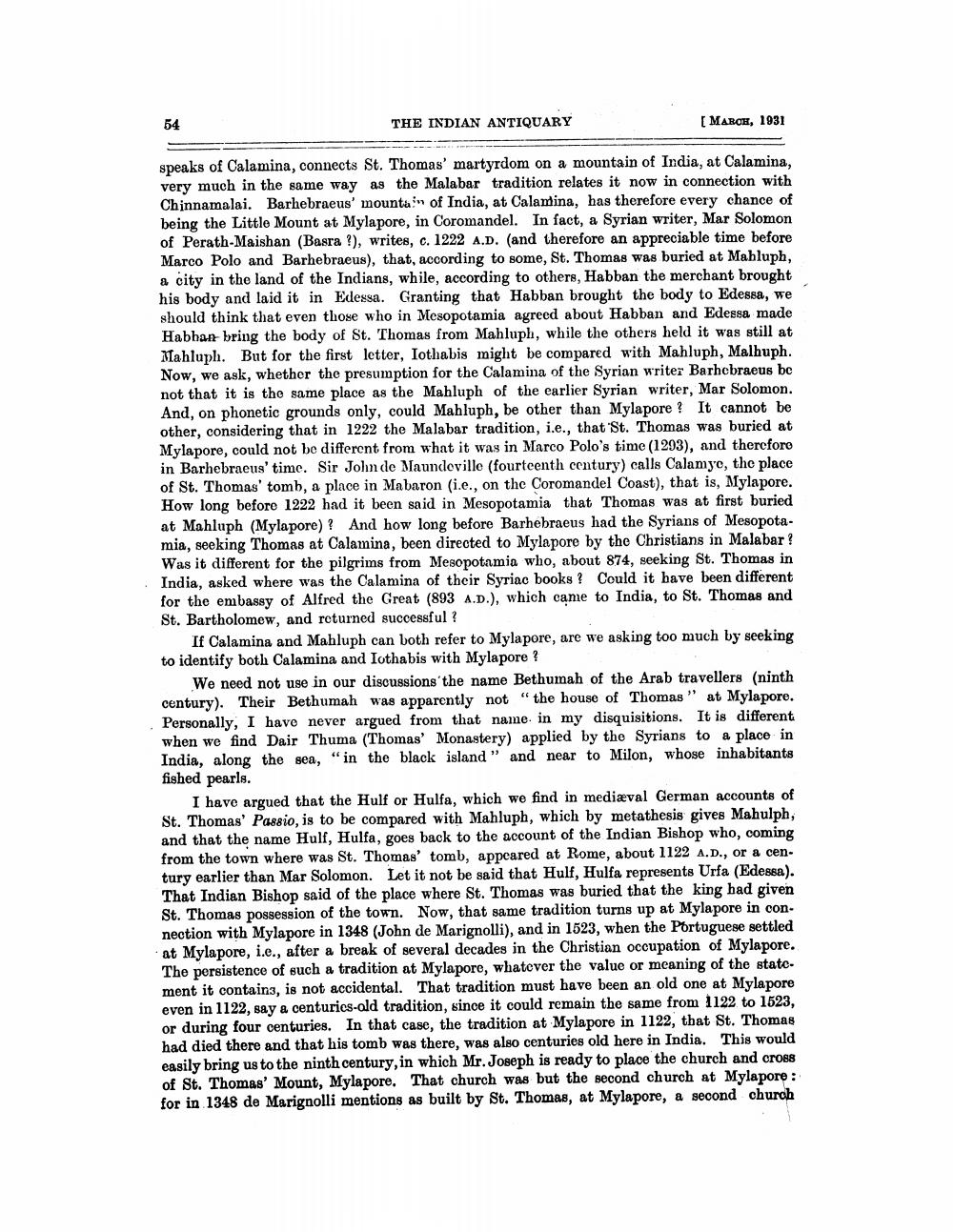________________
54
THE INDIAN ANTIQUARY
[MARCH, 1931
speaks of Calamina, connects St. Thomas' martyrdom on a mountain of India, at Calamina, very much in the same way as the Malabar tradition relates it now in connection with Chinnamalai. Barhebraeus' mountain of India, at Calandina, has therefore every chance of being the Little Mount at Mylapore, in Coromandel. In fact, a Syrian writer, Mar Solomon of Perath-Maishan (Basra ?), writes, c. 1222 A.D. (and therefore an appreciable time before Marco Polo and Barhebraeus), that, according to some, St. Thomas was buried at Mabluph, a city in the land of the Indians, while, according to others, Habban the merchant brought his body and laid it in Edessa. Granting that Habban brought the body to Edessa, we should think that even those who in Mesopotamia agreed about Habban and Edessa made Habhan bring the body of St. Thomas from Mahluph, while the others held it was still at Mahluph. But for the first letter, Iothabis might be compared with Mahluph, Malhuph. Now, we ask, whether the presumption for the Calamina of the Syrian writer Barhebraeus be not that it is the same place as the Mahluph of the earlier Syrian writer, Mar Solomon. And, on phonetic grounds only, could Mahluph, be other than Mylapore? It cannot be other, considering that in 1222 the Malabar tradition, i.e., that St. Thomas was buried at Mylapore, could not be different from what it was in Marco Polo's time (1293), and therefore in Barhebraeus' time. Sir John de Maundeville (fourteenth century) calls Calamye, the place of St. Thomas' tomb, a place in Mabaron (i.e., on the Coromandel Coast), that is, Mylapore. How long before 1222 had it been said in Mesopotamia that Thomas was at first buried at Mahluph (Mylapore)? And how long before Barhebraeus had the Syrians of Mesopotamia, seeking Thomas at Calamina, been directed to Mylapore by the Christians in Malabar! Was it different for the pilgrims from Mesopotamia who, about 874, seeking St. Thomas in India, asked where was the Calamina of their Syriac books ? Could it have been different for the embassy of Alfred the Great (893 A.D.), which came to India, to St. Thomas and St. Bartholomew, and returned successful ?
If Calamina and Mahluph can both refer to Mylapore, are we asking too much by seeking to identify both Calamina and Iothabis with Mylapore ?
We need not use in our discussions'the name Bethumah of the Arab travellers (ninth century). Their Bethumah was apparently not "the house of Thomas" at Mylapore. Personally, I have never argued from that name in my disquisitions. It is different when we find Dair Thuma (Thomas' Monastery) applied by the Syrians to a place in India, along the sea, "in the black island” and near to Milon, whose inhabitants fished pearls.
I have argued that the Hulf or Hulfa, which we find in mediæval German accounts of St. Thomas' Passio, is to be compared with Mahluph, which by metathesis gives Mahulph, and that the name Hulf, Hulfa, goes back to the account of the Indian Bishop who, coming from the town where was St. Thomas' tomb, appeared at Rome, about 1122 A.D., or a cen. tury earlier than Mar Solomon. Let it not be said that Hulf, Hulfa represents Urfa (Edessa). That Indian Bishop said of the place where St. Thomas was buried that the king had given St. Thomas possession of the town. Now, that same tradition turns up at Mylapore in con. nection with Mylapore in 1348 (John de Marignolli), and in 1523, when the Portuguese settled at Mylapore, i.e., after a break of several decades in the Christian occupation of Mylapore. The persistence of such a tradition at Mylapore, whatever the value or meaning of the statement it contains, is not accidental. That tradition must have been an old one at Mylapore even in 1122, say a centuries-old tradition, since it could remain the same from 1122 to 1523, or during four centuries. In that case, the tradition at Mylapore in 1122, that St. Thomas had died there and that his tomb was there, was also centuries old here in India. This would easily bring us to the ninth century, in which Mr. Joseph is ready to place the church and cross of St. Thomas' Mount, Mylapore. That church was but the second church at Mylapore : for in 1348 de Marignolli mentions as built by St. Thomas, at Mylapore, a second church




